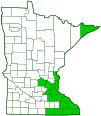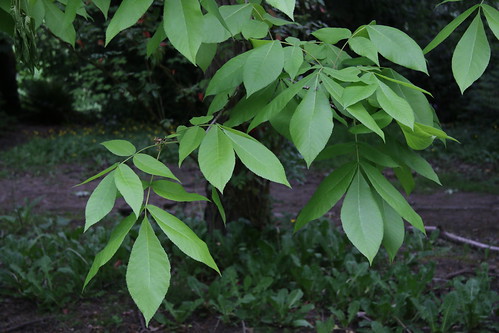northern shagbark hickory
(Carya ovata)
Conservation • Wetland • Description • Habitat • Ecology • Use • Distribution • Taxonomy
Description |
||
Northern shagbark hickory is a slow-growing, deciduous, hardwood tree. It rises on a single stem from a deep root system with a central taproot. In Minnesota mature trees are usually 40′ to 60′ tall and up to 24″ in diameter at breast height. Large individuals can reach 130′ in height and 48 ″ in diameter. It is a long-lived tree, often surviving 200 years. The trunk is straight, slender, and spreading at the base. It is distinct into the upper part of the crown and is often free of branches for ¾ of its length. The crown is narrow, rounded, and irregular. The branches are short, ascending, and spreading. The bark on young trees is thin, smooth, and dark gray. As it ages it becomes ashy gray and separates into long strips that are loosely attached at the middle. These strips are free and curl away from the trunk at the top and bottom. The bark is shaggy in appearance, much like silver maple. It is the tree’s most distinctive feature and makes recognition easy. The twigs are stout, grayish-brown to reddish-brown, with numerous lighter dots (lenticels). In their first year they are covered with whitish hairs. In the second year they become less hairy or hairless. They are round in cross section and have star-shaped pith. The leaf scars are slightly raised and 3-lobed to semicircular. They have many bundle scars that are either scattered or arranged in 3 clusters forming a monkey face pattern. Terminal buds are tan to dark brown, ⅜″ to ¾″ long, and egg-shaped, with 6 to 9 thin, overlapping scales. The outer scales are loosely spreading and often broken. The inner scales are densely covered with short, matted or tangled, soft, woolly hairs. Lateral buds are similar but much shorter, diverge from the twig, and have 2 protective bracts at the base. The leaves are deciduous, alternate, 8″ to 14″ long, and pinnately divided into usually 5, rarely 7, leaflets. They are on 2″ to 4¾″ long, minutely hairy leaf stalks. The 3 upper leaflets are elliptical or narrowly elliptical, 4″ to 8″ long, and 1 3 ⁄16″ to 3½″ wide. The 2 basal leaflets are similar in shape but much smaller. The terminal leaflet is the largest of the 5. It is sometimes inversely egg-shaped and is on a 3 ⁄16″ to ⅝″ long leaf stalk. The lateral leaflets are stalkless or nearly stalkless. The blades are widest in the middle and taper toward both ends. They taper unevenly to a blunt base, and taper to a point at the tip with concave sides along the tip. The upper surface is dark yellow-green and hairless. The lower surface is pale yellow-green and hairless except occasionally for hairs along the midvein. The margins are finely or coarsely toothed with sharp, forward pointing teeth. There are 2 or 3 small tufts of white hairs below the summit of each tooth. These may not be visible without a hand lens. In autumn the leaves turn golden yellow. Male and female flowers are borne on the same branch. They appear when the leaves are nearly full size in early May to early mid-June. The male inflorescence is 3 cylindrical, drooping clusters (catkins) of numerous tiny flowers. Each catkin is 2⅜″ to 4¾″ long. The 3 catkins are attached to a single stalk rising from the base of current-year twigs, and from leaf axils of previous season leaves. The female inflorescence is 2 to 4 flowers on a 5 ⁄16″ long spike at the end of current-year twigs. The fruit is a nut enclosed in a thick, tan, woody husk. The husk is 1⅜″ to 1 9 ⁄16″ long, slightly less wide, ⅛″ to ⅝″ thick, and spherical but somewhat compressed on the top. It is split into 4 sections by sutures that run from the stalk to the base. They are not winged but are ribbed at the sutures. The fruit ripens in September and October and is dispersed from September to December. The ripened husk splits open at the base to release the nut. The nut is oblong egg-shaped, compressed at the top, prominently 4-angled near the top, and rounded at the base. The shell is thin and the kernel is sweet and edible. |
||
Height |
||
40′ to 60′ |
||
Record |
||
The champion northern shagbark hickory in Minnesota is on state property in or near Freeburg, in Houston County. In 2009 it was measured at 93′ tall and 92″ in circumference (29″ in diameter), with a crown spread of 59′. |
||
Flower Color |
||
Green |
||
Similar Species |
||
Bitternut hickory (Carya cordiformis) bark forms shallow ridges and furrows, not peeling strips. Current-year twigs have whitish hairs near the tip but are otherwise hairless. The buds are sulphur-yellow and have 2 to 4 valve-like bud scales. The leaves have 7 or 9, rarely 11, leaflets. The leaf margins do not have small tufts of hairs. The fruits are smaller, ¾″ to 1 3 ⁄16″ long, and have a thin, leathery husk. Green ash (Fraxinus pennsylvanica) leaf margins do not have small tufts of hairs. Southern shagbark hickory (Carya carolinae-septentrionalis) has shorter catkins and smaller fruits. It does not occur in Minnesota. Wild sarsaparilla (Aralia nudicaulis) plants look similar to hickory seedlings. The outer (closest to the petiole) leaflets of sarsaparilla leaves are always larger than the inner (closest to the terminal segment) leaflets. |
||
Habitat |
||
Moist to dry. Wet bottomlands, dry uplands, exposed ridge tops, south-facing slopes. Shade tolerant when young. |
||
Ecology |
||
Flowering |
||
Early May to early mid-June |
||
Pests and Diseases |
||
|
||
Use |
||
|
||
Distribution |
||||
|
Sources |
|||
| 5/22/2023 | ||||
Nativity |
||||
Native |
||||
Occurrence |
||||
Common |
||||
Taxonomy |
|||
| Kingdom | Plantae (Plants) | ||
| Division | Tracheophyta (Vascular Plants) | ||
| Subdivision | Spermatophytina (Seed Plants) | ||
| Class | Magnoliopsida (Dicots) | ||
Order |
Fagales (Beeches, Oaks, Walnuts, and Allies) | ||
Family |
Juglandaceae (walnut) | ||
| Subfamily | Juglandoideae (walnut) | ||
| Tribe | Juglandeae | ||
| Subtribe | Caryinae | ||
| Genus | Carya (hickory) | ||
| Section | Carya (typical hickories) | ||
Synonyms |
|||
Carya ovata var. fraxinifolia Carya ovata var. nuttallii Carya ovata var. ovata Carya ovata var. pubescens Hicoria alba Hicoria borealis Hicoria ovata |
|||
Common Names |
|||
northern shagbark hickory scalybark hickory shagbark shagbark hickory shellbark hickory upland hickory |
|||
Glossary
Axil
The upper angle where a branch, stem, leaf stalk, or vein diverges.
Bract
Modified leaf at the base of a flower stalk, flower cluster, or inflorescence.
Catkin
A slim, cylindrical, drooping cluster of many flowers. The flowers have no petals and are either male or female but not both.
Lenticel
A corky, round or stripe-like, usually raised, pore-like opening in bark that allows for gas exchange.
Pinnate
On a compound leaf, having the leaflets arranged on opposite sides of a common stalk. On a bryophyte, having branches evenly arranged on opposite sides of a stem.
Visitor Photos |
|||||
Share your photo of this plant. |
|||||
| This button not working for you? Simply email us at info@MinnesotaSeasons.com. Attach one or more photos and, if you like, a caption. |
|||||
Randy |
|||||
Shagbark hickory, October 2017, Freeborn County, Minnesota. |
|||||
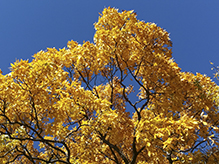 |
|||||
Shagbark hickory nuts, October 2017, Freeborn County, Minnesota. |
|||||
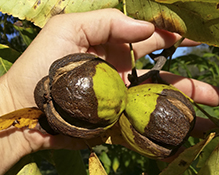 |
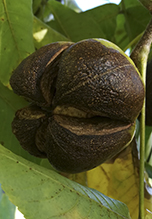 |
||||
Stand of Northern Shagbark Hickory in winter |
|||||
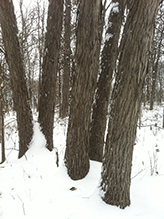 |
|||||
Stand of Northern Shagbark Hickory |
|||||
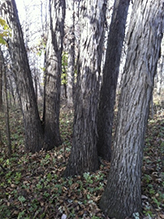 |
|||||
Basswood on left next to Shagbark |
|||||
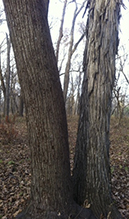 |
|||||
Double-trunked shagbark hickory |
|||||
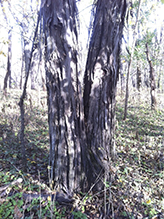 |
|||||
Deep green late-summer foliage of northern shagbark hickory |
|||||
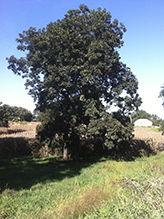 |
|||||
Northern Shagbark Hickory, Freeborn County, MN, August 2016 |
|||||
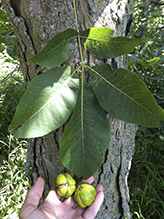 |
|||||
View into canopy of Northern Shagbark Hickory growing wild in Freeborn County, MN, at the very western edge of the natural range of the species |
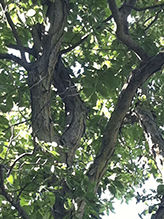 |
||||
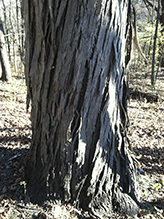 |
|||||
MinnesotaSeasons.com Photos |
|||||
Bark |
|||||
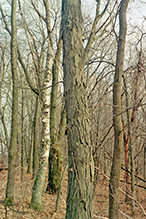 |
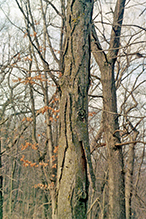 |
||||
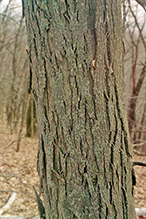 |
|||||
Leaves |
|||||
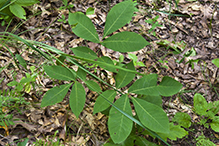 |
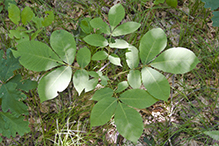 |
||||
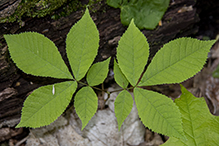 |
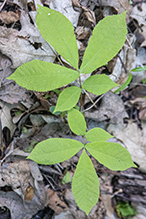 |
||||

Visitor Videos |
|||
Share your video of this plant. |
|||
| This button not working for you? Simply email us at info@MinnesotaSeasons.com. Attach a video, a YouTube link, or a cloud storage link. |
|||
Other Videos |
|||
| Trees with Don Leopold - shagbark hickory ESFTV |
|||
About
Uploaded on Oct 10, 2011 No description available. |
|||
| Shagbark Hickory identification ( Carya Ovata). It is a tree that early squirrel hunters look for wvoutdoorman |
|||
About
Published on Aug 26, 2012 Shagbark Hickory identification video ( Carya Ovata) It is a tree that early squirrel hunters look for because of the prized nuts that they love. |
|||
| How to ID Carya ovata Laura Deeter |
|||
About
Uploaded on Oct 7, 2008 brief video covering the name and key ID features for Carya ovata |
|||
| Shagbark Hickory SoMoCon's channel |
|||
About
Published on Mar 24, 2013 Shagbark Hickory is an interesting tree with a distinctive look. |
|||
| Shagbark hickory tree Pat Rick |
|||
About
Uploaded on Jul 21, 2011 http://www.tytyga.com/product/Shagbark+Hickory+Tree |
|||

Visitor Sightings |
|||||
Report a sighting of this plant. |
|||||
| This button not working for you? Simply email us at info@MinnesotaSeasons.com. Be sure to include a location. |
|||||
| Randy October 2017 |
Location: Freeborn County, Minnesota |
 |
|||
| Randy 9/2016 |
Location: near IA/MN border Deep green late-summer foliage of northern shagbark hickory |
 |
|||
| Randy 8/9/2016 |
Location: Freeborn County, MN |
 |
|||
| Randy 9/20/2015 |
Location: Freeborn County, MN View into canopy of Northern Shagbark Hickory growing wild in Freeborn County, MN, at the very western edge of the natural range of the species |
 |
|||
MinnesotaSeasons.com Sightings |
|||||

|
Created: Last Updated: © MinnesotaSeasons.com. All rights reserved. |
